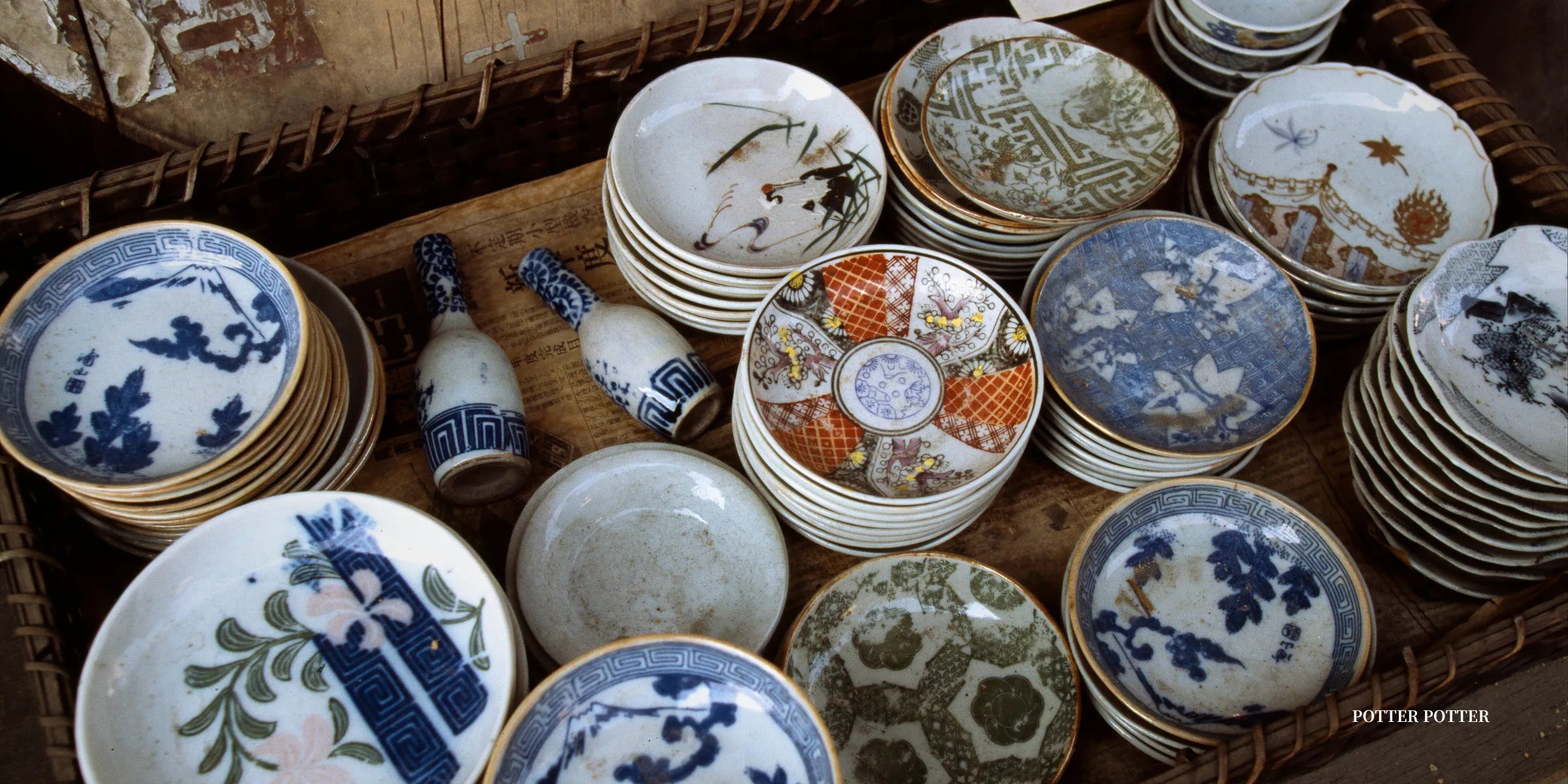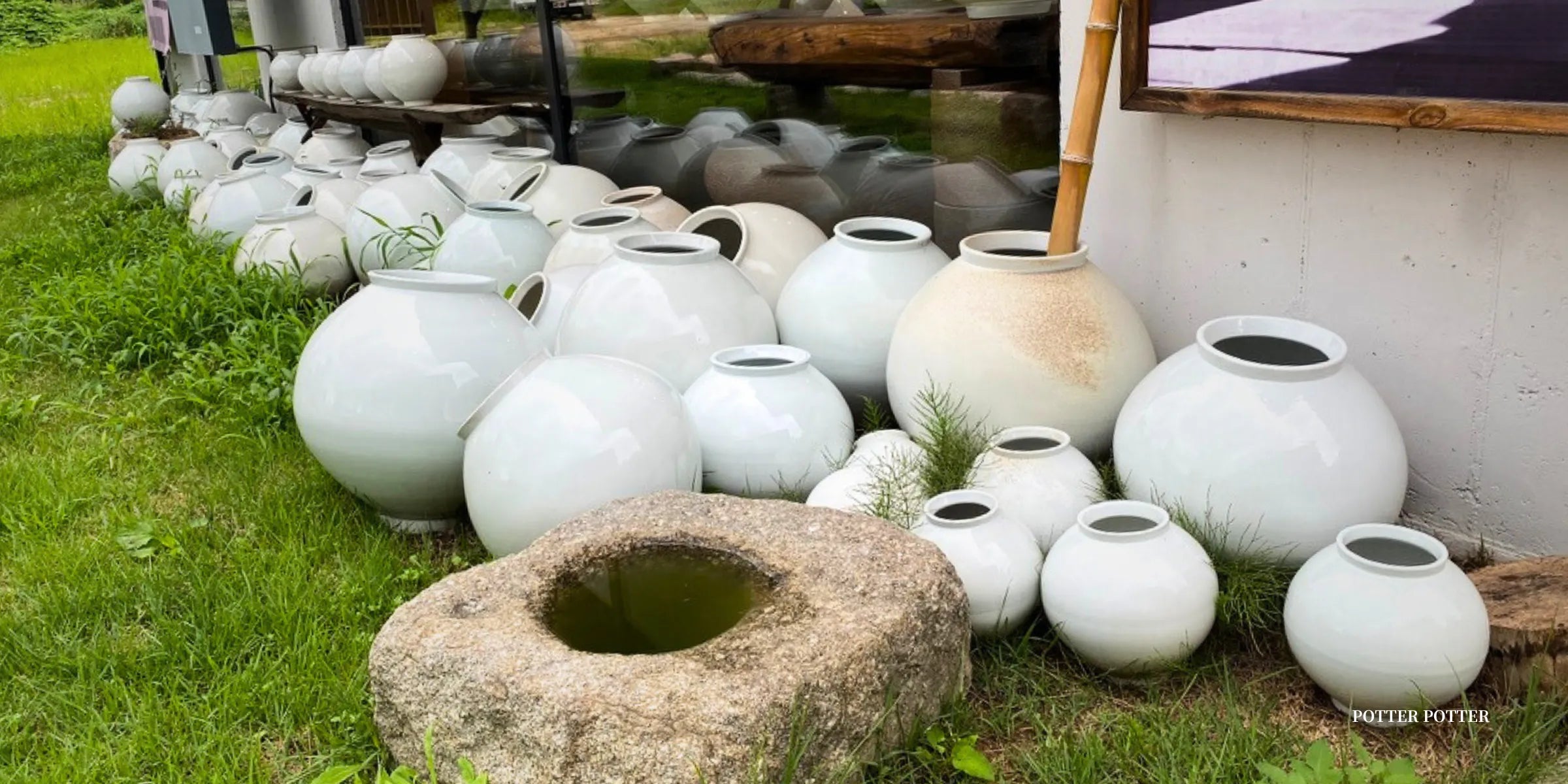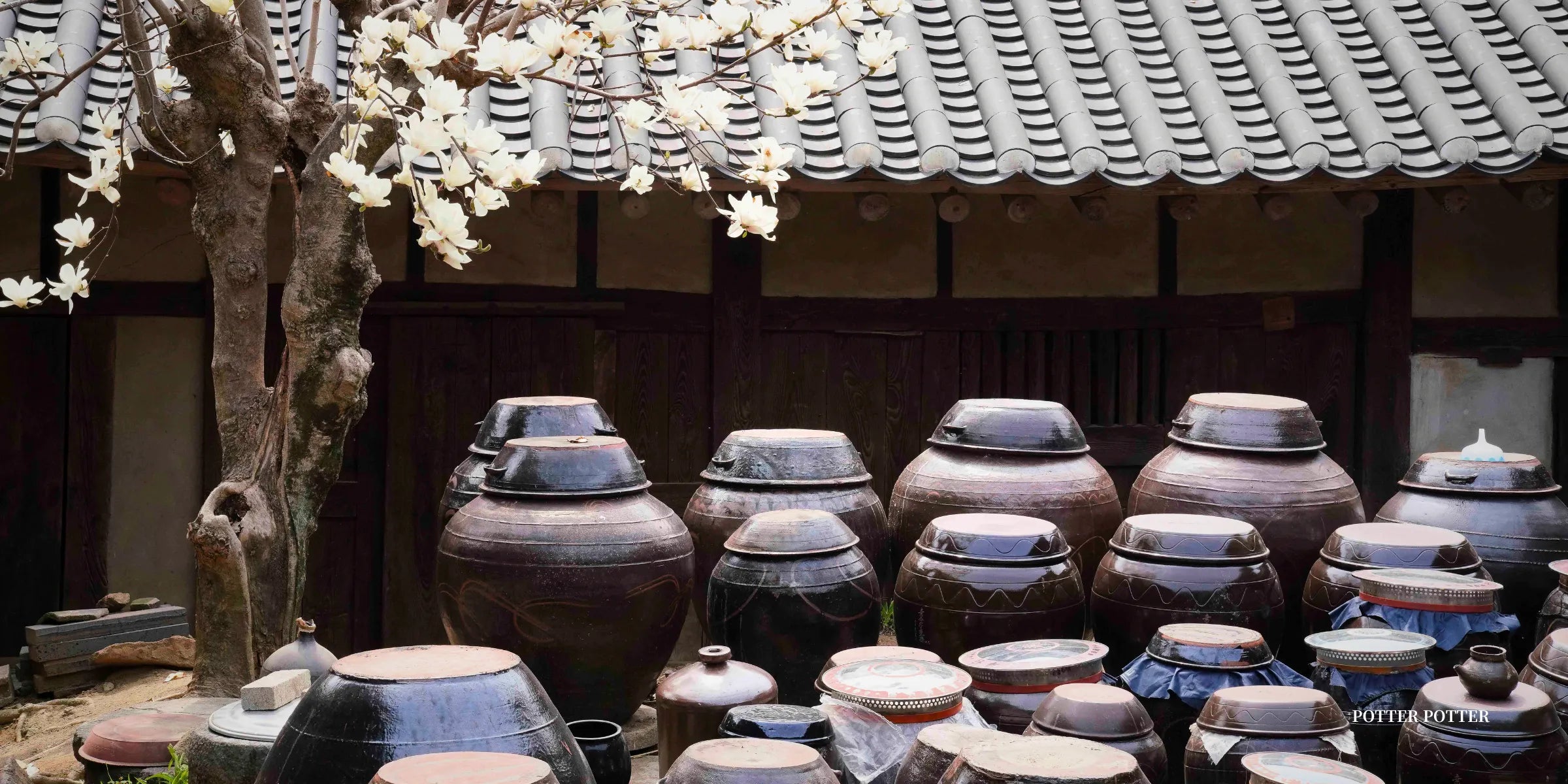
Japanese Pottery Regions: The Six Ancient Kilns and Traditional Craft Potteries
What makes Japanese pottery so unique, and how has it become a symbol of both functionality and artistry? Japanese pottery regions boast a rich history, steeped in tradition, and craftsmanship that has been handed down through generations. From rustic stoneware to finely crafted porcelain, each region tells a story through its unique methods, techniques, and designs.

|
Table of Contents |
Basic Categorization of Japanese Pottery

Japanese pottery can be categorized into several distinct groups based on historical and regional factors. These categories offer a way to appreciate the diversity of styles and techniques that have developed over centuries.
-
Rokkoyo (六古窯)
This term refers to the six ancient kilns in Japan, which are recognized as the origin of traditional Japanese ceramics. These kilns have maintained their cultural importance and continue to produce pottery today. -
Traditional Craft Pottery (伝統的工芸品)
Japan is home to 26 other traditional pottery regions, each with its unique styles, techniques, and contributions to the world of ceramics. -
Individual Artist Works
In addition to the established regions, contemporary potters and artists contribute significantly to Japan’s pottery scene. Their innovative works push the boundaries of traditional techniques, blending modern artistry with age-old craftsmanship.
Exploring the Six Ancient Kilns
The “Rokkoyo” (六古窯) represents the six ancient kilns of Japan, each with a rich heritage dating back over a thousand years. These kilns are vital to understanding the roots of Japanese ceramics.
-
Seto Ware (瀬戸焼)
Known for its wide range of products, Seto ware is one of Japan’s most famous pottery styles. Located in Aichi Prefecture, Seto developed during the Heian period and continues to be a major pottery-producing region. Its versatility includes everything from daily-use ceramics to intricate art pieces, and it’s especially known for the use of glazes such as Oribe and Shino. -
Tokoname Ware (常滑焼)
Hailing from Aichi Prefecture as well, Tokoname is famed for its distinctive red clay and the production of teapots, particularly the “kyusu.” Tokoname’s legacy stretches back to the Heian period and is one of the oldest kilns in Japan. The unglazed red pottery is known for its elegant simplicity and durability. -
Bizen Ware (備前焼)
Located in Okayama Prefecture, Bizen ware is one of Japan’s oldest pottery traditions, known for its unglazed, wood-fired appearance. Its rustic, earthy tones, combined with distinctive surface textures, make each piece unique. Bizen pottery is often characterized by the absence of glaze, which allows the natural qualities of the clay to shine through, making it ideal for tea ceremonies and artistic displays. -
Shigaraki Ware (信楽焼)
Originating from Shiga Prefecture, Shigaraki ware is best known for its tanuki (raccoon dog) statues and traditional storage jars. Its rough texture and natural ash glaze make it one of the most recognizable pottery styles in Japan. The kilns in Shigaraki have been active since the Kamakura period, producing both functional and decorative ceramics. -
Tamba Ware (丹波焼)
Located in Hyogo Prefecture, Tamba pottery is recognized for its traditional use of natural glazes and wood-fired kilns. Known for its durability, Tamba ware includes items such as jars, pots, and vases, often used for storing water or sake. The pottery has a characteristic simplicity, with natural hues of brown and black. -
Echizen Ware (越前焼)
This pottery from Fukui Prefecture is renowned for its robust, rustic designs. Originating in the Heian period, Echizen ware is mainly used for functional purposes, such as storage jars and bowls. The natural beauty of its simple design, enhanced by the subtle variations in clay color and texture, makes it a staple in traditional Japanese homes.
26 Traditional Pottery Regions in Japan
Beyond the six ancient kilns, Japan boasts numerous other pottery regions, each contributing to the diversity of Japanese ceramics. These regions include:
-
Ōbori Sōmayaki (大堀相馬焼)
Originating in Fukushima during the Edo period, Ōbori Sōmayaki is famous for its “crackled glaze” and hand-painted galloping horse motif. Known for its unique double-walled construction, this pottery retains heat well. It has survived challenges, including competition and natural disasters, and remains a beloved traditional craft. -
Aizu Hongo Yaki (会津本郷焼)
Aizu Hongo Yaki, from Fukushima, began in the late 16th century. Combining both porcelain and pottery techniques, its styles vary from blue and white underglaze to multicolored overglaze works. Known for practical, rustic wares, the region’s schools also contribute to the craft, emphasizing ceramic chemistry and innovation. -
Mashiko Yaki (益子焼)
Mashiko Yaki, from Tochigi Prefecture, is renowned for its earthy, rustic ceramics, typically featuring thick glazes in natural tones of brown and black. It gained global fame thanks to Hamada Shōji, a key figure in the mingei (folk art) movement. Mashiko continues to host large pottery fairs, celebrating its heritage. -
Kasama Yaki (笠間焼)
Kasama Yaki, from Ibaraki Prefecture, dates back to the 18th century. Known for its adaptability, it embraces a wide range of styles from traditional to avant-garde. With its robust and versatile pieces, Kasama Yaki ceramics are popular for everyday use, showcasing unique glazes and free-form techniques. -
Akazu Yaki (赤津焼)
Located in the Seto region of Aichi Prefecture, Akazu Yaki is known for its distinctive glazes and traditional craftsmanship. Its roots trace back to ancient kilns, producing tea wares, bowls, and decorative items. The craft emphasizes high-quality, ornate pieces with deep cultural ties to the Japanese tea ceremony. -
Mikawa Yaki/Sanshu Kawara (三河焼・三州瓦)
Mikawa Yaki from Aichi is renowned for its production of roof tiles, called Sanshu Kawara. Its pottery includes architectural ceramics and traditional roofing materials. Historically significant for its durability, Mikawa Yaki has expanded into artistic ceramics, blending traditional craftsmanship with modern techniques. -
Mino Yaki (美濃焼)
Mino Yaki from Gifu Prefecture is one of Japan’s largest pottery-producing regions. Famous for traditional styles like Shino, Oribe, and Setoguro, Mino Yaki ceramics are known for their bold use of glaze and rustic designs. These ceramics are highly valued for tea ceremony wares and everyday items. -
Yokkaichi Banko Yaki (四日市萬古焼)
Banko Yaki from Yokkaichi, Mie Prefecture, is known for its heat-resistant ceramics, making it ideal for cookware such as teapots and earthenware pots. Its distinctive purple clay is popular in teapots, combining functionality and beauty. Banko Yaki’s legacy is deeply rooted in practicality and traditional craftsmanship. -
Iga Yaki (伊賀焼)
Iga Yaki, from Mie Prefecture, is known for its rugged and earthy ceramics with natural kiln effects like bidoro (glass-like drips) and koge (scorch marks). Originating in the late 16th century, these ceramics are highly appreciated for tea ceremony wares and functional, rustic vessels. -
Kutani Yaki (九谷焼)
Kutani Yaki from Ishikawa Prefecture is famous for its vibrant, multicolored overglaze decoration. With roots dating back to the 17th century, this style often features bold, intricate designs and five signature colors: green, yellow, red, purple, and blue. Kutani ceramics are highly regarded as both decorative and functional pieces. -
Izushi Yaki (出石焼)
Izushi Yaki, from Hyogo Prefecture, is famous for its delicate, translucent white porcelain. Known as “Japan’s white jewel,” it often features intricate carvings and detailed designs. Originating in the Edo period, Izushi Yaki pieces, such as tea sets and vases, are prized for their purity and craftsmanship. -
Kyo Yaki / Kiyomizu Yaki (京焼・清水焼)
Kyoto’s Kyo Yaki and Kiyomizu Yaki are known for their elegance and refined designs, often associated with tea ceremony wares and decorative pieces. These ceramics often feature intricate hand-painting with vibrant colors. Rooted in the cultural heritage of Kyoto, they exemplify both beauty and function. -
Iwami Yaki (石見焼)
Iwami Yaki from Shimane Prefecture dates back to the Edo period, famous for producing large-scale items like water jars and storage vessels. It features simple, utilitarian designs and thick, durable bodies, often used for everyday household goods, including traditional Japanese earthenware. -
Hagi Yaki (萩焼)
Hagi Yaki, from Yamaguchi Prefecture, is famous for its soft, porous clay and subdued colors. Known for its subtlety, Hagi Yaki is highly valued in tea ceremonies due to its ability to “age” gracefully as the glaze cracks and changes over time, giving each piece a unique character. -
Tobe Yaki (砥部焼)
Tobe Yaki, from Ehime Prefecture, is known for its sturdy porcelain with a distinctive cobalt-blue underglaze. Traditionally used for everyday items such as dishes and bowls, Tobe Yaki pieces are practical yet beautiful, featuring simple, hand-painted designs inspired by nature. -
Koishiwara Yaki (小石原焼)
Koishiwara Yaki from Fukuoka Prefecture is known for its rustic, folk art-inspired pottery, featuring traditional techniques like hakeme (brushed slip) and tobikanna (chatter marks). These techniques give Koishiwara Yaki a simple, earthy aesthetic, making it a beloved choice for functional, everyday ceramics. -
Ōtani Yaki (大谷焼)
Ōtani Yaki from Tokushima Prefecture is famous for its large-scale ceramic jars and vases. These pieces are made using a unique method called ne-roku, where potters work in pairs, one using their feet to turn the wheel. This tradition continues today, producing both practical and artistic works. -
Imari / Arita Yaki (伊万里・有田焼)
Imari and Arita Yaki from Saga Prefecture are renowned for their exquisite porcelain, characterized by intricate blue-and-white designs and vibrant overglaze decoration. With origins dating back to the early 17th century, these ceramics are prized for their beauty and exported widely as luxury items. -
Karatsu Yaki (唐津焼)
Karatsu Yaki from Saga Prefecture is known for its simple, rustic beauty, often featuring iron glaze and natural ash glazes. One of the oldest pottery styles in Japan, Karatsu Yaki is valued for tea wares and traditional vessels, emphasizing the natural beauty of the clay and glaze. -
Agano Yaki (上野焼)
Agano Yaki from Fukuoka Prefecture dates back to the early 17th century. Known for its light, elegant forms and subtle glazes, Agano Yaki ceramics are often used in tea ceremonies. The craft is celebrated for its fine, delicate shapes and restrained aesthetic. -
Hasami Yaki (波佐見焼)
Hasami Yaki from Nagasaki Prefecture has been producing everyday porcelain since the early 17th century. Known for its blue-and-white designs and mass production techniques, Hasami Yaki ceramics are both affordable and beautiful, offering practical tableware that is beloved in households across Japan. -
Shodai Yaki (小代焼)
Shodai Yaki from Kumamoto Prefecture is known for its rugged, rustic ceramics with distinctive glazing techniques, often featuring drips and natural color variations. These pottery pieces are functional and valued for their simplicity, durability, and connection to Japan’s folk craft tradition. -
Mikawachi Yaki (三川内焼)
Mikawachi Yaki from Nagasaki Prefecture is renowned for its fine white porcelain and delicate, hand-painted blue designs. Often featuring intricate patterns such as the famous karako (children) motif, Mikawachi Yaki combines beauty and refinement, with roots in the porcelain traditions of the Edo period. -
Satsuma Yaki (薩摩焼)
Satsuma Yaki from Kagoshima Prefecture is divided into two styles: white Satsuma, characterized by finely detailed overglaze painting, and black Satsuma, with rustic, earthy tones. Both styles are highly valued, with white Satsuma particularly famous for its intricate, decorative artistry. -
Amakusa Toujiki (天草陶磁器)
Amakusa Toujiki, from Kumamoto Prefecture, is known for its high-quality porcelain clay, which produces beautiful white ceramics. The region’s pottery often features simple, elegant designs, and its porcelain is used widely in Japanese tableware, emphasizing purity and functionality. -
Tsuboya Yaki (壷屋焼)
Tsuboya Yaki from Okinawa combines influences from mainland Japan, China, and Southeast Asia. Known for its bold designs and practical functionality, Tsuboya Yaki is famous for both Ara-yaki (unglazed earthenware) and Jo-yaki (glazed pottery). The Shisa (guardian lion-dog statues) and unique pottery shapes like dachibin (portable sake containers) are iconic. Tsuboya Yaki reflects Okinawa’s distinct culture and history, blending tradition with modern artistic expression.
Pottery and Modern Japanese Artists
Contemporary pottery in Japan has seen a resurgence, with many artists pushing the boundaries of traditional techniques. These modern potters take inspiration from the ancient kilns but are not bound by tradition. Instead, they experiment with new forms, glazes, and firing techniques to create innovative works that appeal to both local and international collectors.
Artists like Shiro Tsujimura and Ken Matsuzaki are renowned for their ability to blend traditional aesthetics with modern sensibilities. Their works often command high prices at auctions and are displayed in galleries worldwide. These potters draw on the long history of Japanese ceramics while adding their own unique interpretations, creating pieces that reflect the continuity of tradition and the excitement of modern art.
The End.
Japan’s pottery regions are more than just places where ceramics are made—they are living testaments to centuries of craftsmanship, tradition, and cultural heritage. Each region offers something unique, whether it’s the rustic charm of Bizen ware or the elegance of Arita porcelain. For those looking to explore Japanese pottery, visiting these regions provides an opportunity to witness the beauty of the craft firsthand.
To experience the full scope of Japanese pottery, consider visiting pottery festivals, such as the Mashiko Pottery Fair or the Seto Pottery Festival. These events offer a rare chance to meet the artisans, explore traditional kilns, and purchase authentic pieces directly from the source. The rich tradition and continued innovation in Japanese pottery make it a fascinating subject for both collectors and casual admirers alike.


